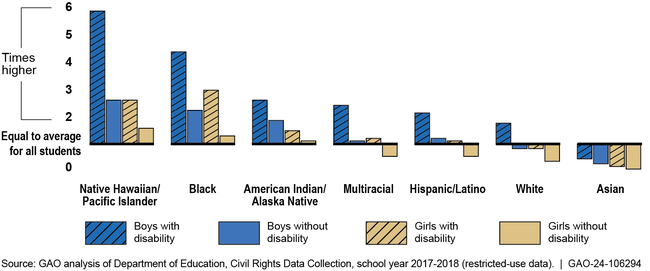K-12 Education: Differences in Student Arrest Rates Widen when Race, Gender, and Disability Status Overlap
Fast Facts
We reviewed the Department of Education's data on school police and the arrest rates of students of different races in the nation's K-12 schools.
Students' race and ethnicity, gender, and disability status mattered when it came to rates of arrest and referrals to police. Specifically, the most recent available data (2017-18) showed that Native Hawaiian/Pacific Islander, Black, and American Indian/Alaska Native students were arrested at rates 2 to 3 times higher than those of White students. For boys in these groups who had a disability, arrest rates were even higher.
We recommended that Education collect additional data on this issue, and more.

Highlights
What GAO Found
GAO's analysis of the Department of Education's data collected from nearly every U.S. school district found that students' race and ethnicity, gender, and disability status were all prominent with respect to rates of arrest and referrals to police, especially when the characteristics intersected. Specifically, in school year 2017–2018, the most recent year of data prior to the pandemic, Native Hawaiian/Pacific Islander, Black, and American Indian/Alaska Native students were arrested at rates that were two to three times higher than White students. For boys who had a disability, the differences in arrest rates widened further.
Arrest Rates for K-12 Student Groups Compared to National Average for All K-12 Students, School Year 2017–2018

Note: For more details, see fig. 3 in GAO-24-106294. “With disability” refers to students that receive services under the Individuals with Disabilities Education Act.
Education's guidance explains that when race, gender, and disability status intersect, students might experience discrimination due to the combination of protected characteristics. Yet, Education does not collect arrest and referral data by race for students receiving services only under Section 504 of the Rehabilitation Act of 1973, as amended. Section 504 prohibits discrimination on the basis of disability by recipients of federal funding. Education officials said to date, they believe the burden on districts outweighs the benefit; however, they also said they always reevaluate what data they collect and will reconsider collecting such data for the 2025-2026 data collection. Having this data is important; as GAO's analysis shows, the intersection of particular characteristics affects student arrest rates. Also, Education modified the arrest definition for school year 2021–2022, but did not tell districts about the new definition before they collected the data. This raises the risk that districts used the old definition, which could affect data quality. Disclosing data limitations also aids those that use the data.
Arrest rates more than doubled in schools with police present compared to similar schools without police, according to GAO's analysis. Among the 51 percent of schools with police present at least once a week, GAO found that arrests were more common when the police were involved in student discipline.
Why GAO Did This Study
The Departments of Education and Justice are responsible for enforcing certain federal civil rights laws that prohibit discrimination in K-12 schools based on characteristics such as race, sex, and disability, including regarding police interactions with students.
The House committee report for the Departments of Labor, Health and Human Services, Education, and Related Agencies Appropriations Bill, 2023, includes a provision for GAO to review the role of policing in schools, including the effect on students of different races. This report addresses (1) what Education's data show about the extent to which different student groups are arrested in K-12 schools and (2) whether police presence in schools is associated with student arrests.
GAO analyzed two federal Education datasets for the two most recent school years before the pandemic (2015–2016 and 2017–2018) and 2019–2020. GAO also visited three school districts, selected for factors such as high rates of arrests; reviewed federal laws and regulations; and interviewed federal officials and representatives of national education and civil rights groups.
Recommendations
GAO is making three recommendations that Education: (1) collect arrest and referral data, by race, for students with disabilities who receive services under Section 504; (2) disclose the limitations of its 2021–2022 arrest data; and (3) clearly inform school districts about future changes to arrest and referral data in its civil rights data collection. Education generally agreed with these recommendations.
Recommendations for Executive Action
| Agency Affected | Recommendation | Status |
|---|---|---|
| Department of Education | The Secretary of Education should ensure that the Assistant Secretary of the Office for Civil Rights revise the Civil Rights Data Collection to collect arrest and referral data, by race, for students with disabilities served under Section 504 of the Rehabilitation Act of 1973, as amended. (Recommendation 1) |
Education agreed with this recommendation. As of December 2024, OCR officials told us they have sought public comment on the benefits and burdens for collecting more detailed data on the intersection of race and disability regarding referrals to law enforcement and school-related arrests for the 2025‒26 and 2027-28 CRDC. OCR officials indicated the office will review and consider all the public comments that it receives on this topic as it develops a revised proposal for requesting information and considers related final comments. OCR intends to share the final request language with GAO after the agency obtains final comments, makes any further changes, and receives OMB's approval. GAO will revisit the status of this recommendation at that time.
|
| Department of Education | The Secretary of Education should ensure that the Assistant Secretary of the Office for Civil Rights take necessary steps to disclose the known limitation in its arrest data for the 2021–2022 school year Civil Rights Data Collection. This could include, for example, confirming and disclosing which definitions school districts used or noting that arrest data for that year is not comparable among districts. (Recommendation 2) |
Education agreed with this recommendation. As of December 2024, OCR officials informed GAO that OCR will disclose the revision to the definition of school related arrest and caution users about comparing arrest data among school districts in the resources released with the 2021‒22 CRDC expected in early 2025. We will consider closing this recommendation when this effort is completed.
|
| Department of Education | The Secretary of Education should ensure that the Assistant Secretary of the Office for Civil Rights clearly communicate any future changes to data on arrests and referrals to law enforcement in the Civil Rights Data Collection before the start of the school year for which districts are to collect data. (Recommendation 3) |
Education agreed with this recommendation. As of December 2024, OCR officials indicated that OCR will communicate the referral and arrest data elements collected in the CRDC prior to the start of the school year, particularly when there are changes to the data elements or definitions from prior data collections. OCR is currently in the process of seeking OMB approval on its proposed 2025-26 and 2027-28 information request and anticipates obtaining OMB approval by the spring of 2025, ahead of the start of the 2025‒26 school year. In the current request, OCR does not propose any changes to the referral and arrest data elements or their corresponding definitions. However, OCR officials state they plan to communicate final data elements and definitions and flag new terms or definitions to the school districts, via email and technical assistance documents, prior to the start of the 2025-26 school year.
|
